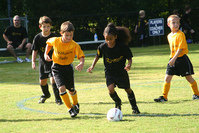

Photo by susieq3c on flickr.
The Department of Parks and Recreation doesn’t allocate its resources in a way that matches the gender composition of the District. We are split, more or less, 50/50. Shouldn’t DC support its citizens’ recreational needs accordingly?
The top five recreational activities that girls participate in are: dancing, swimming, basketball, jogging, volleyball. For boys, the ranking goes: basketball, football, soccer, jogging, swimming.
And yet, at least in Ward 3, that’s not how DPR allocates its land or facilities—not even close. Neither baseball nor softball make either gender’s list of top activities, but there are at least 14 public baseball fields in Ward 3. And girls are far less likely to play baseball than boys.
Numerous studies have shown that physical activity and recreation are essential to physical, emotional, and intellectual health. The White House, the American Medical Association, and numerous other organizations recognize the importance of the issue, as witnessed by the First Lady’s “Let’s Move” campaign. A recent study shows that urban children in particular get more exercise when they have the opportunity to play outside. And both boys and girls need exercise.
Allocating half the outdoor recreational space in Northwest DC to an activity that attracts less than one tenth of half the population leaves a lot of those kids to fend for themselves. This is a problem we can fix with compromise and consideration and by asking the right questions.
Perhaps our starting assumptions are biased. A lack of cyclists on dangerous arterial roads doesn’t prove cyclists wouldn’t ride on them if it were safe to do so. And it’s possible there’s no clear demand for girl’s facilities because they can’t even begin to play their sports.
In the 1990s, Vienna, Austria, realized that in formulating its urban policy it hadn’t taken into account the problems that women and girls faced. So it started a successful program to redesign the city to meet their needs. DPR needs a similar strategy for identifying interest and providing facilities for all potential participants.
Otherwise, the message the city is sending our girls is either “we’re just not that concerned about you,” or “we haven’t thought that much about you.” My eyes have been opened to this situation as an equity issue because I have daughters. But no one should be comfortable with anything resembling those attitudes.
Physical activity, and how our city provides appropriate facilities for it, is not something frivolous. It has far-reaching implications for the individual, the community, the country, and beyond.
We should ask ourselves how we decide what uses are best for our green space and what kinds of facilities will meet the needs of both boys and girls.
Top image: Photo by susieq3c on flickr.